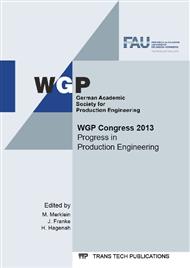p.131
p.139
p.147
p.157
p.165
p.173
p.181
p.189
p.197
Influence of Material Model Parameters on the Prediction of Bending Loads in Sheet Metal Forming Simulation
Abstract:
The demands on accuracy of forming simulation rised sharply in recent years due to increasing manufacturing costs and intensive application of lightweight materials in automotive industry. The accuracy of prediction of forming simulation depends mainly on the use of material models, pre-processing parameters and friction modelling. For isolated investigation of individual parameters a new test has been developed at the Institute for Metal Forming Technology (IFU), University of Stuttgart. This buckling-bending-test allows a frictionless investigation of bending processes. Within preliminary investigation buckling-bending-tests were carried out using an aluminium sheet material. The strain on the outer skin of the specimen was measured in-situ during the test by the use of an optical measuring system. According to the experiments, a forming simulation of the buckling-bending-test was generated using LS-Dyna. The parameters necessary for the pre-processing, such as element size, refinement levels and meshing parameters were examined in a separate simulation study to determine the optimum for the subsequent simulation study. The approaches of Ludwik, Hollomon, Gosh and Swift have been used to describe the flow curve. It was found out that the best match can be achieved by an extrapolation according to Ludwik. The improvement of prediction amounts to 5 per cent. The description of the yield locus depends on the material file used for the simulation. In this investigation the material models MAT_18, MAT_36, MAT_37, MAT122 and MAT_133 have been used. It was shown that the prediction of bending loads can be approved by the use of the yield locus description of Barlat.
Info:
Periodical:
Pages:
165-172
Citation:
Online since:
September 2013
Authors:
Keywords:
Price:
Сopyright:
© 2013 Trans Tech Publications Ltd. All Rights Reserved
Share:
Citation:


